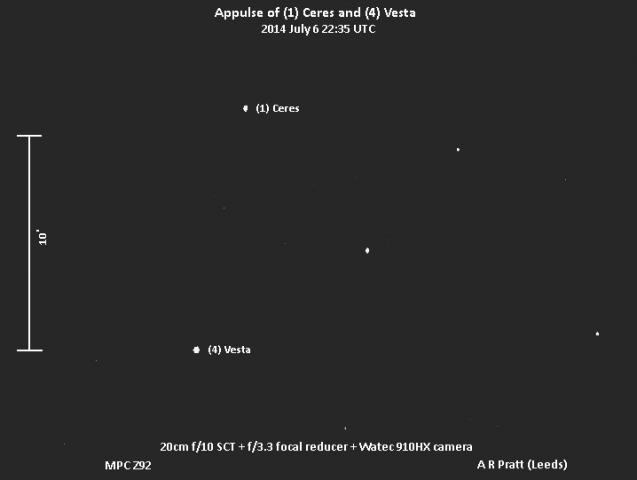- This topic has 8 replies, 2 voices, and was last updated 11 years, 4 months ago by
 Alex Pratt.
Alex Pratt.
-
AuthorPosts
-
2 January 2014 at 2:14 pm #573311
Dominic Ford (site admin)
ParticipantPosted by Graham Relf at 14:14 on 2014 Jan 02
As 1 Ceres and 4 Vesta follow each other for much of 2014 we have started providing monthly combined charts for them on the asteroid charts page of the Computing Section site. These are interactive charts from which ephemeris data can be seen if your mouse cursor is close to either track.Monthly updates to asteroid finder charts around opposition (to mag 12) have just been put on the same page.
4 January 2014 at 4:42 pm #576428Dominic Ford (site admin)
ParticipantPosted by Richard Miles at 16:42 on 2014 Jan 04
Thanks for this Graham.I must mention that back in 2012 October, Jean Meeus added the following comment to an e-mail note about the opposition brightnesses of Ceres and Vesta:"There is something else that is interesting about Ceres and Vesta.In April 2014, these two asteroids will reach opposition with theSun at a time inteval of less than 48 hours. During almost eightmonths they will stay less than 5 degrees from each other in thesky, and during almost two months at less than 2 degrees.On 2014 July 5 their angular separation will be only 10 arcminutes,their least angular distance since at least the year 1800."Jean MeeusSince we know that Vesta changes colour slightly as it rotates, whereas Ceres does not, it would be useful to verify whether these changes can be detected photometrically. Maybe the easiest way of doing this is to do a time-series of images using a DSLR camera with enough FOV that both objects are on the same frame and then to extract the Red, Green and Blue FITS files and measure the relative B-V, V-R and B-R magnitude of Vesta relative to Ceres vs. time. Vesta rotates in just 5.34 hours so a 6-hr run should follow more than an entire rotation.
5 January 2014 at 9:53 am #576429Dominic Ford (site admin)
ParticipantPosted by A R Pratt at 09:53 on 2014 Jan 05
Hi Richard,That’s an interesting project.What do you think would be the amplitude of Vesta during the 6 hours? About 0.1 mag in the visual?Clear skies, Alex.
5 January 2014 at 5:47 pm #576433Dominic Ford (site admin)
ParticipantPosted by Richard Miles at 17:47 on 2014 Jan 05
Alex – The lightcurve amplitude of Vesta is small, like you say, at between 0.08-0.19 mag depending on its heliocentric longitude for the present apparition. That of Ceres ranges from 0.02-0.06 mag.By doing colour difference magnitudes, such as (B-R) for Vesta MINUS (B-R) for Ceres, any variation in general brightness of the two objects cancels out and we are left with colour changes only. Since DSLRs do 3 colours at a time, and these asteroids are both brighter than magnitude 8.5 (Vesta reaches mag 5.7 in April), these cameras are pretty ideal tools for the job. The only thing to watch will be to use a short enough exposure time to avoid saturating pixels in the image of Vesta.I’ll look to write a short ‘How To’ crib sheet for folk planning on having a go. If several people tried it then the combination of all would be better than an effort by one person only.There might be a spin-off too in that it could kick start more use of DSLRs for variable star observations as well as those of asteroids!
5 January 2014 at 8:26 pm #576434Dominic Ford (site admin)
ParticipantPosted by Martin Cole at 20:26 on 2014 Jan 05
I would be interested in this, using a DSLR. I’m attempting to do the same for much fainter asteroids using a CCD, this would be a useful complement. That crib-sheet might have to be written..
6 January 2014 at 5:19 pm #576435Dominic Ford (site admin)
ParticipantPosted by Steve Holmes2 at 17:19 on 2014 Jan 06
Further to Jean Meeus’ comment, I make it that their closest encounter will in fact be on 7th July – just 6arc-minutes! Not all that high in the sky and with a waxing Moon around, but an historic encounter nonetheless.
6 January 2014 at 6:34 pm #576436Dominic Ford (site admin)
ParticipantPosted by Richard Miles at 18:34 on 2014 Jan 06
Steve using MPC ephemerides, here is what I find:Appulse of Ceres (V=8.4) and Vesta (V=7.1), 2014 JulyAs seen from southern UK (MPC Code J77)Optimal UK-based observing interval: 22:00-23:00 UT on July 05Year Month Day HH:hh(UT) Sep.(‘) Alt.20147509:00 10.00-3420147510:009.97-2620147511:009.96-1820147512:009.92-0920147513:009.92+0120147514:009.91+1020147515:009.91+1920147516:009.89+2720147517:009.88+3320147518:009.90+3720147519:009.92+3720147520:009.91+3520147521:009.93+3020147522:009.94+2320147523:009.97+1520147600:009.99+0620147601:0010.01-04
8 January 2014 at 12:23 am #576439Dominic Ford (site admin)
ParticipantPosted by Steve Holmes2 at 00:23 on 2014 Jan 08
Thanks Richard – a timely (and indeed salutary!) reminder that if one is going to look for close approaches of minor bodies it might be a good idea to make sure your ephemerides are up to date! On investigation, mine were not. Having updated them from the MPC data (and checked them using Solex 11), I find the same result as given in your post.So, as that well-loved radio programme used to say: "I’m sorry, I’ll read that again – I make the closest approach 10arc-sec on 5th July"!!
16 July 2014 at 1:10 pm #576607 Alex PrattParticipant
Alex PrattParticipantThis rare event occurred at a difficult time for mid-northern latitude observers, with the asteroids very low down in the SW in the summer twilight.
Local obstructions blocked the view from my observatory, although I managed to record them by setting up a portable mount in another part of the garden. July 5/6 was bright and sunny, then as the twilight darkened the forecast ‘clear sky’ turned into thick cloud.
The night of July 6/7 was better, which produced the attached pic.

Clear skies,
Alex.
-
AuthorPosts
- You must be logged in to reply to this topic.
